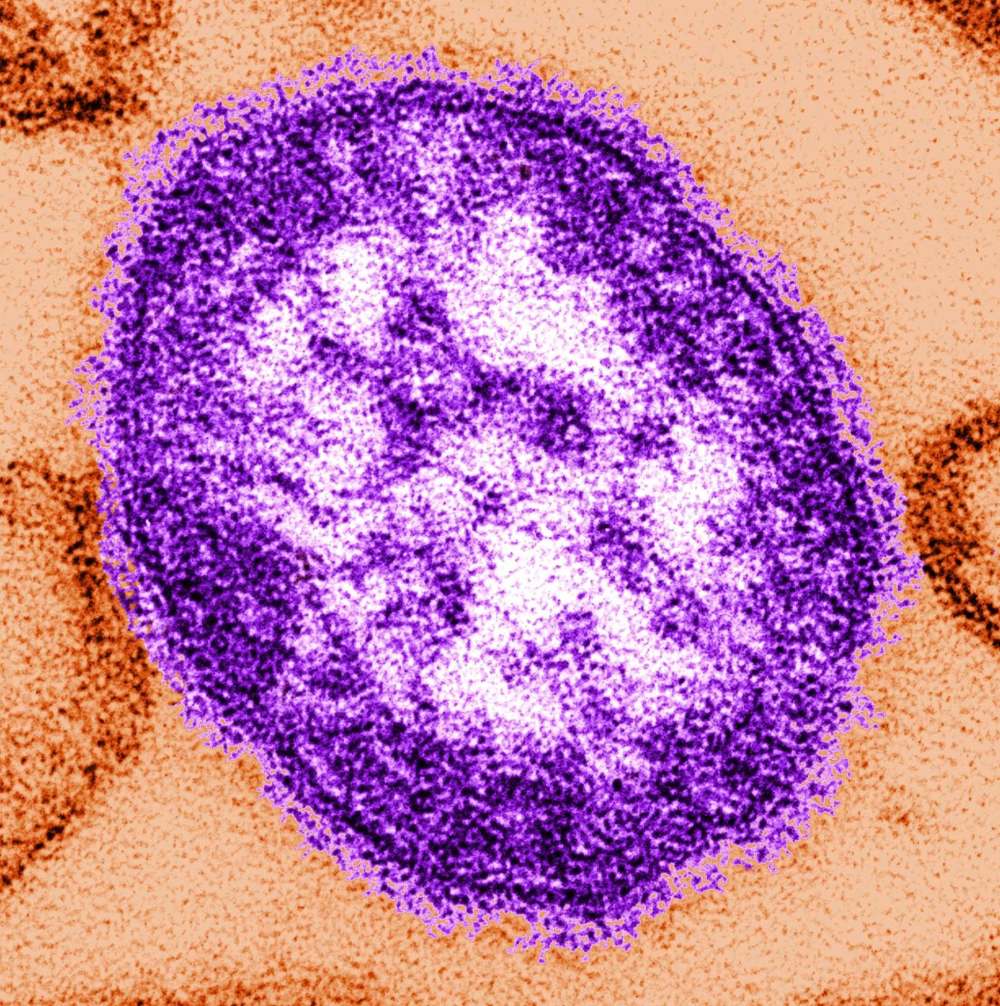Measles ‘disaster’ could happen here: MD
Read this article for free:
or
Already have an account? Log in here »
To continue reading, please subscribe:
Monthly Digital Subscription
$0 for the first 4 weeks*
- Enjoy unlimited reading on winnipegfreepress.com
- Read the E-Edition, our digital replica newspaper
- Access News Break, our award-winning app
- Play interactive puzzles
*No charge for 4 weeks then price increases to the regular rate of $19.00 plus GST every four weeks. Offer available to new and qualified returning subscribers only. Cancel any time.
Monthly Digital Subscription
$4.75/week*
- Enjoy unlimited reading on winnipegfreepress.com
- Read the E-Edition, our digital replica newspaper
- Access News Break, our award-winning app
- Play interactive puzzles
*Billed as $19 plus GST every four weeks. Cancel any time.
To continue reading, please subscribe:
Add Free Press access to your Brandon Sun subscription for only an additional
$1 for the first 4 weeks*
*Your next subscription payment will increase by $1.00 and you will be charged $16.99 plus GST for four weeks. After four weeks, your payment will increase to $23.99 plus GST every four weeks.
Read unlimited articles for free today:
or
Already have an account? Log in here »
Hey there, time traveller!
This article was published 17/04/2019 (2432 days ago), so information in it may no longer be current.
Winnipeg is facing a measles "disaster," says an expert who fears low vaccination rates in the city are putting people at risk of the virus that can have devastating effects.
Only 67 per cent of Winnipeg children born in 2008 have had the recommended two doses of measles vaccine, an analysis of vaccination data last year by Manitoba public health officials found. The number is even lower in one pocket of north St. Vital, where only 55 per cent of children have been vaccinated for measles.
"If those data are correct, I would characterize it as a disaster," said Dr. Brian Ward, professor of medicine and microbiology at McGill University in Montreal.

"Those have got to be some of the lowest vaccine coverage rates in the country," said Ward, co-director of the McGill Vaccine Study Centre and deputy director of the Research Institute of the McGill University Health Centre.
"The target is 95 per cent" to have herd immunity protecting the population, said Ward. "In the 50s and 60s is really horrible."
Measles is an acute, highly communicable viral infection, also known as rubeola. It causes a rash, high fever and cough, and can lead to a number of health problems, including sore throat, ear infection, diarrhea, or pneumonia. Sometimes, it can lead to inflammation of the brain and seizures.
It’s one of the leading causes of vaccine-preventable deaths in children worldwide, according to Health Canada.
"Measles is one of — if not the most — infectious viruses known to humans. Exposure in a big city that has a lot of travellers and tourists is inevitable," said Ward, who saw children in Philadelphia die from measles during an outbreak in 1990.
"Measles is a really, really bad disease whether you get it at two years of age or 50."
#g-measles-box .g-artboard {
margin:0 auto;
}
#g-measles-box .g-artboard p {
margin:0;
}
.g-aiAbs {
position:absolute;
}
.g-aiImg {
display:block;
width:100% !important;
}
.g-aiSymbol {
position: absolute;
box-sizing: border-box;
}
.g-aiPointText p { white-space: nowrap; }
#g-measles-artboard-200 {
position:relative;
overflow:hidden;
}
#g-measles-artboard-200 p {
font-family:Open Sans,sans-serif;
font-weight:400;
font-size:10px;
line-height:12px;
filter:alpha(opacity=100);
-ms-filter:progid:DXImageTransform.Microsoft.Alpha(Opacity=100);
opacity:1;
letter-spacing:0em;
text-align:left;
color:rgb(0,0,0);
text-transform:none;
padding-bottom:0;
padding-top:0;
mix-blend-mode:normal;
font-style:normal;
height:auto;
}
#g-measles-artboard-200 .g-pstyle0 {
font-weight:700;
font-size:16px;
line-height:19px;
}
#g-measles-artboard-200 .g-pstyle1 {
font-size:16px;
line-height:19px;
}
#g-measles-artboard-200 .g-pstyle2 {
font-size:12px;
line-height:10px;
text-align:center;
}
#g-measles-artboard-200 .g-pstyle3 {
font-weight:700;
font-size:12px;
line-height:14px;
}
#g-measles-artboard-200 .g-pstyle4 {
font-weight:700;
font-size:12px;
line-height:14px;
text-align:right;
}
#g-measles-artboard-200 .g-pstyle5 {
line-height:14px;
}
#g-measles-artboard-400 {
position:relative;
overflow:hidden;
}
#g-measles-artboard-400 p {
font-family:Open Sans,sans-serif;
font-weight:400;
font-size:10px;
line-height:12px;
filter:alpha(opacity=100);
-ms-filter:progid:DXImageTransform.Microsoft.Alpha(Opacity=100);
opacity:1;
letter-spacing:0em;
text-align:left;
color:rgb(0,0,0);
text-transform:none;
padding-bottom:0;
padding-top:0;
mix-blend-mode:normal;
font-style:normal;
height:auto;
}
#g-measles-artboard-400 .g-pstyle0 {
font-weight:700;
font-size:16px;
line-height:19px;
}
#g-measles-artboard-400 .g-pstyle1 {
font-size:16px;
line-height:19px;
}
#g-measles-artboard-400 .g-pstyle2 {
font-size:12px;
line-height:19px;
text-align:center;
}
#g-measles-artboard-400 .g-pstyle3 {
font-weight:700;
font-size:16px;
line-height:19px;
text-align:right;
}
#g-measles-artboard-400 .g-pstyle4 {
line-height:14px;
}
#g-measles-artboard-650 {
position:relative;
overflow:hidden;
}
#g-measles-artboard-650 p {
font-family:Open Sans,sans-serif;
font-weight:400;
font-size:12px;
line-height:14px;
filter:alpha(opacity=100);
-ms-filter:progid:DXImageTransform.Microsoft.Alpha(Opacity=100);
opacity:1;
letter-spacing:0em;
text-align:left;
color:rgb(0,0,0);
text-transform:none;
padding-bottom:0;
padding-top:0;
mix-blend-mode:normal;
font-style:normal;
height:auto;
}
#g-measles-artboard-650 .g-pstyle0 {
font-weight:700;
font-size:16px;
line-height:19px;
}
#g-measles-artboard-650 .g-pstyle1 {
font-size:16px;
line-height:19px;
}
#g-measles-artboard-650 .g-pstyle2 {
text-align:center;
}
#g-measles-artboard-650 .g-pstyle3 {
font-weight:700;
font-size:16px;
line-height:19px;
text-align:right;
}
#g-measles-artboard-650 .g-pstyle4 {
font-size:10px;
}

Measles vaccination rates
Percentage of 2008 birth cohort receiving 2 of 2 doses
0 %
50
60
70
80
100
Seven Oaks
Inkster
Transcona
St. James
Downtown
Assiniboine South
St. Vital
St. Vital North
55%
Fort Garry South
58%
Source: Winnipeg Regional Health Authority

Measles vaccination rates
Percentage of 2008 birth cohort receiving 2 of 2 doses
0 %
50
60
70
80
100
Seven Oaks
Inkster
Transcona
St. James
Downtown
Assiniboine South
St. Vital
St. Vital North
55%
Fort Garry South
58%
Source: Winnipeg Regional Health Authority

Seven Oaks
Inkster
Measles vaccination rates
Percentage of 2008 birth cohort receiving 2 of 2 doses
Transcona
St. James
Downtown
Assiniboine South
0 %
50
60
70
80
100
St. Vital
St. Vital North
55%
Fort Garry South
58%
Source: Winnipeg Regional Health Authority
Winnipeg has been "lucky" to see just a few cases reported over the last few years, medical officer of health Dr. Bunmi Fatoye said in a column penned for the Free Press for National Immunization Awareness Week.
The Winnipeg Regional Health Authority said its last confirmed case of the measles was in October 2018. Now, with the data gathered late last year, Fatoye warned as many as one in three Winnipeg children born in 2008 may be at risk.
Public health officials have long-stressed the importance of widespread vaccination to create "herd immunity" — the protection provided when 90 to 95 per cent of the population is vaccinated. In Manitoba, the average for children born in 2008 is 73 per cent.
In Ontario and New Brunswick, where vaccines are mandatory for children before they can enter school, the vaccination rates are from 81 to 96 per cent, says the Canadian Paediatric Society. But neither Ward nor the society’s Dr. Joan Robinson, an infectious diseases physician at the Stollery Children’s Hospital in Edmonton, support mandatory vaccinations.

They both fear some parents would see legislated immunization as an infringement on their rights, leading to fury and increasing mistrust of the medical profession. The goal should be parents immunize their children because they understand the benefits, the doctors say.
"I think that we give too much publicity to the small percentage of parents who are truly anti-immunization," said Robinson who has been researching ways to improve vaccination rates.
"There are way more parents who either: one, just didn’t get around to it; or two, are uncertain so just avoid the issue," she said.
"I think that our best strategy is to work harder at encouraging parents to have their children immunized by extending clinic hours and pouring more resources into school immunization programs. If we tried harder to get consent to immunize kids in schools, I think that we could update immunizations for most of them."
Manitoba’s Health Minister Cameron Friesen said, "While we strongly encourage Manitobans to protect themselves and their children with immunizations, we have confidence in our current approaches, which are consistent with those in most other jurisdictions.
"Manitoba was the first province in Canada to create a province-wide immunization registry in 1988. To this day, we continue to have a robust method of reporting vaccines, allowing public health officials to access the most accurate data possible on vaccine coverage.
"We engage in many initiatives to provide the opportunity for Manitobans to be immunized as part of the Routine Immunization Schedule while continuously examining ways of increasing coverage among all segments of the population, including school-aged children. We are continuing to look at ways to increase uptake of immunizations through education of the public and health-care providers and creating resources that allow parents to make the best evidence-informed decision for their family."
Measles was once common in Canada
Before vaccinations, more than 300,000 Canadians caught the measles every year. Some recovered completely; many did not. In 1926, almost 900 Canadians died because of the measles. Survivors risked living with lifelong complications such as permanent brain damage or deafness.
In the 1960s, the first measles vaccine was introduced to Canadians. Cases decreased by 99 per cent.
Measles had been eliminated in Canada as a direct result of successful universal vaccination programs.
However, measles is still common in other parts of the world and easy to contract. For that reason, it is possible for cases and outbreaks in Canada.
As of March 31, 33 cases of measles have been reported in 2019 in Quebec, British Columbia, the Northwest Territories, Ontario and Alberta.
— sources: Government of Canada; Canadian Institutes of Health Research
The "anti-vaxer" movement, which tells parents vaccines are worse than the diseases they prevent, isn’t helping, Robinson said.
"Providing parents with information is a double-edged sword, as some find a way to turn the information around and use it as a reason not to immunize," said Robinson. "Some mix up side-effects from the disease with side-effects from immunizations."
Ward said it’s time for parents whose children weren’t vaccinated and suffered to speak out. "We need people to stand up whose children were damaged by one these diseases and say ‘I got bad advice.’"
Canada has a national immunization strategy aiming for an 80 per cent vaccination coverage among adults, and 80 to 95 per cent for infants and children by 2021.
layer
"Everybody should be checking to make sure their vaccinations are up to date," said Ward, who’s studied measles for 30 years in Canada and the U.S.
"Everyone born in this country after 1970 should have received two doses of the vaccine, and even that’s not a 100 per cent guarantee," said Ward, who fears a measles outbreak in North America and Europe is inevitable due to low vaccinations rates.
"Unfortunately, in a situation like this, a large number of children will get hurt because of bad decisions made by their parents. Only then will there be a community memory of how bad these diseases are."
carol.sanders@freepress.mb.ca

Our newsroom depends on a growing audience of readers to power our journalism. If you are not a paid reader, please consider becoming a subscriber.
Our newsroom depends on its audience of readers to power our journalism. Thank you for your support.
History
Updated on Wednesday, April 17, 2019 8:01 PM CDT: Adds related items
Updated on Friday, April 19, 2019 1:59 PM CDT: Corrects spelling of rubeola.















